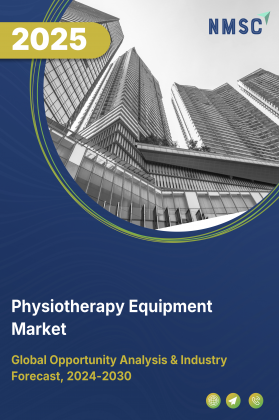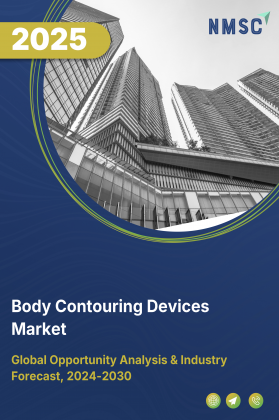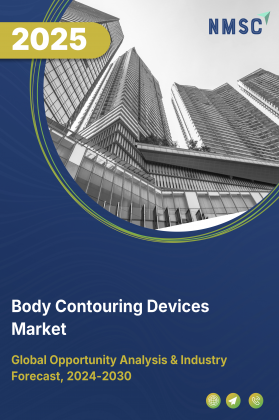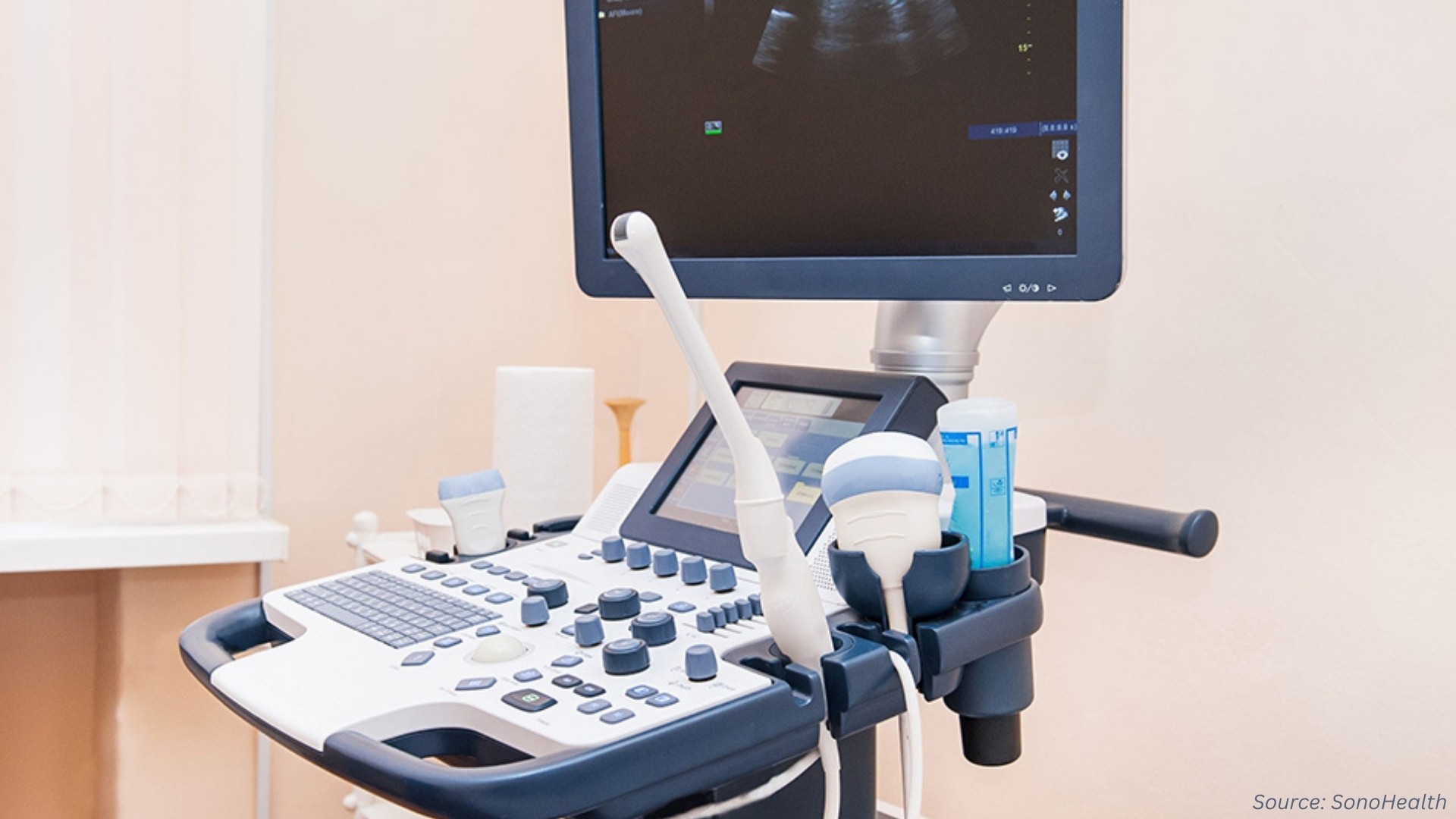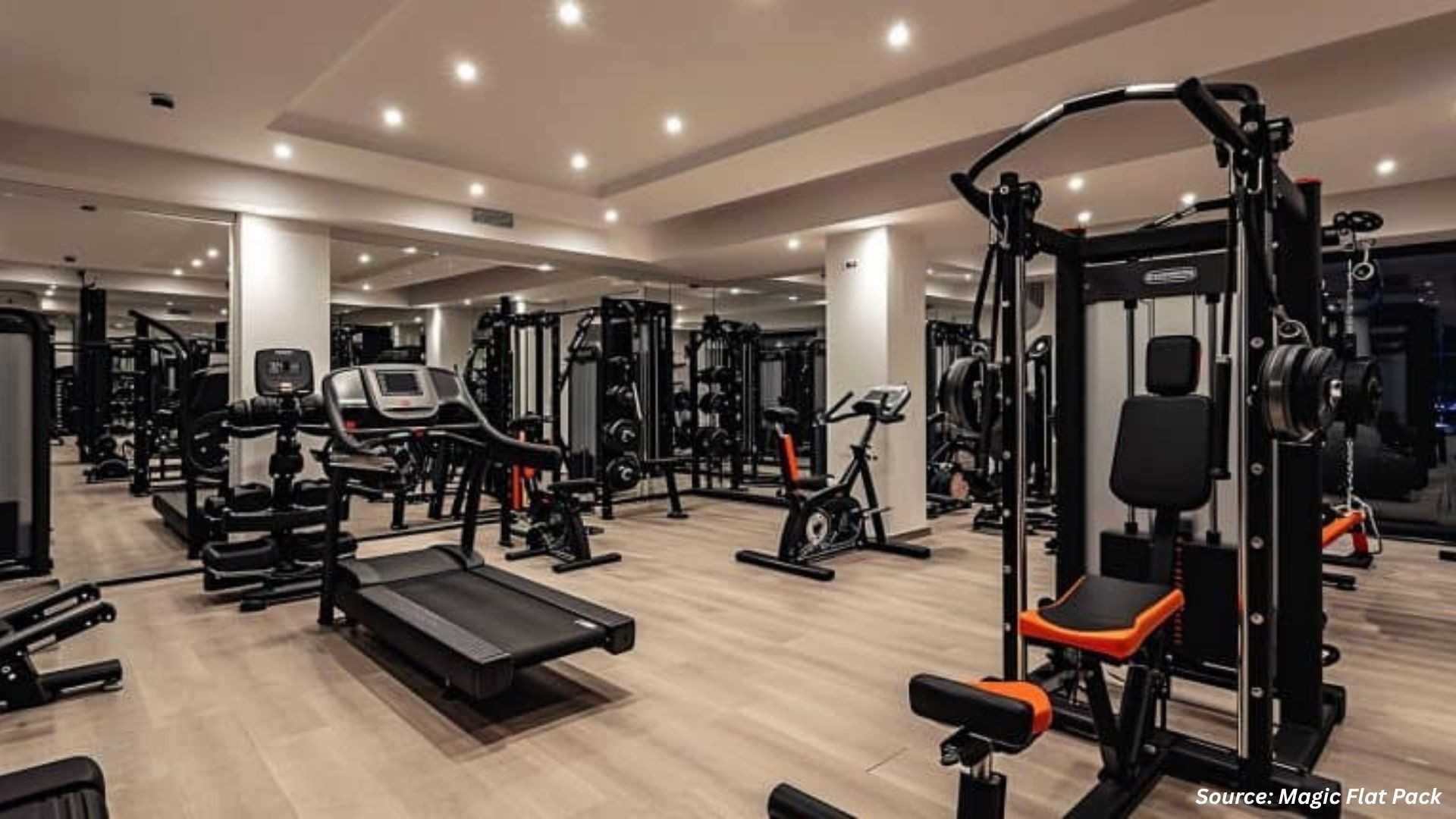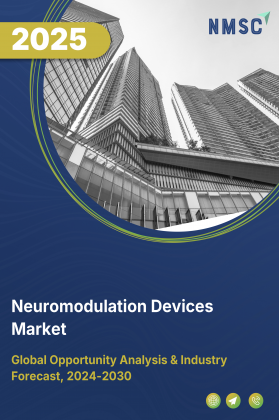
Neuromodulation Devices Market by Component (Implantable Pulse Generators), by Product Type (Peripheral Nerve Stimulation), by Technology Mode (Stimulation Control, Implantation Technique), by Power System (Rechargeable IPGs, non-rechargeable IPGs), by Lead Type (Percutaneous, Paddle), by Biomaterial (Metallic, Polymeric, Ceramic), by Therapeutic Application (Chronic Pain), and by End User (Hospitals & Academic Medical Centers) – Global Opportunity Analysis and Industry Forecast 2025–2030.
Industry Outlook
The global Neuromodulation Devices Market size was valued at USD 7.75 billion in 2024, with an estimation of USD 8.64 billion in 2025 and is predicted to reach USD 14.89 billion by 2030 with a CAGR of 11.5% from 2025-2030.
The neuromodulation devices industry is experiencing robust growth driven by the rising prevalence of neurological disorders, the aging global population, and increasing awareness of advanced therapeutic options. With neurological conditions such as Alzheimer’s, Parkinson’s, chronic pain, and strokes on the rise, demand for effective treatment solutions continues to expand. Growing acceptance of neuromodulation therapies as alternatives or complements to conventional treatments is further fuelling adoption.
However, high device and treatment costs remain a major barrier, particularly in resource-limited settings. Looking ahead, the integration of artificial intelligence into neuromodulation devices offers significant opportunities, enabling personalized, adaptive therapies that enhance efficacy, patient compliance, and long-term outcomes.
Rising Prevalence of Neurological Disorders Drives the Market Growth
The global burden of neurological disorders is increasing at an alarming rate, posing significant challenges to healthcare systems worldwide. According to the American Academy of Neurology (AAN), by 2050, there will be 4.9 billion cases of brain disorders, a 22% rise from 2021. The all-age DALY rate is also expected to grow 10%, from 5,139 DALYs per 100,000 in 2021 to 5,666 DALYs per 100,000 in 2050.
Key conditions driving this trend include headaches, Alzheimer’s disease, depressive and anxiety disorders, and strokes. This growing prevalence highlights the urgent need for advanced treatment solutions, including neuromodulation devices, to manage symptoms and improve patient outcomes.
Aging Global Population Driving Demand for Neuromodulation Devices
The steadily increasing proportion of older adults worldwide is emerging as a significant factor fuelling the neuromodulation devices market demand, as age-related neurological conditions, including Alzheimer’s disease, Parkinson’s disease, and chronic pain syndromes become more prevalent within this demographic.
According to the United Nations, the number of individuals aged 80 or over is projected to triple by 2050, rising from 137 million in 2017 to 425 million, which highlights the growing need for advanced therapeutic interventions that effectively manage symptoms, enhance patient outcomes, and improve the overall quality of life among elderly populations.
Growing Awareness and Acceptance of Neuromodulation Therapies Fuels Market Expansion
Increasing awareness of neurological health issues and the availability of innovative therapeutic options is significantly driving the adoption of neuromodulation devices across the globe. Public health campaigns, growing clinical evidence, and documented positive patient outcomes are encouraging both physicians and patients to consider these devices as effective alternatives or complements to traditional pharmacological treatments.
With the prevalence of brain disorders projected to rise sharply, the recognition and acceptance of neuromodulation therapies are expected to expand in parallel, supporting broader utilization, improving patient outcomes, and ultimately strengthening the neuromodulation devices market for advanced neurological interventions.
High Cost of Devices and Treatment Restrain the Market Growth
The adoption of neuromodulation devices is significantly restrained by their high costs, as these therapies involve advanced technology, surgical implantation, and ongoing maintenance, all of which contribute to substantial expenses. In addition to the upfront device price, patients incur costs for hospital stays, follow-up consultations, and device programming or replacement, making treatment less accessible.
This financial barrier is particularly pronounced in low- and middle-income countries, where healthcare budgets are limited and out-of-pocket expenses be prohibitive. Consequently, despite increasing awareness and demand, the high cost of devices and associated care continues to restrict widespread adoption globally.
Integration of AI in Neuromodulation Devices Creates Future Opportunities for the Market
The integration of artificial intelligence represents a significant growth opportunity for the neuromodulation devices market expansion. AI enables personalized, adaptive therapy by analyzing a patient’s neural patterns in real time, optimizing stimulation, and improving treatment outcomes.
A notable example is the FDA-approved AI-powered wristband in 2025 for patients with essential tremor, which delivers non-invasive neurostimulation tailored to individual neural activity. Such innovations not only enhance efficacy and patient compliance but also open doors for broader applications, including remote monitoring and predictive therapy adjustments, positioning companies to capitalize on the next generation of advanced neurological care.
Market Segmentation and Scope of Study
The neuromodulation devices market report is segmented by component, product type, technology mode, power system, lead type, biomaterial, therapeutic application, end user, and region. Components include implantable pulse generators, leads and electrodes, external programmers, chargers, and accessories. Product types cover implantable devices and external devices. Technology modes include stimulation control and implantation techniques. Power systems span rechargeable, non-rechargeable, and externally powered devices, while lead types include percutaneous, paddle, and leadless systems. End users include hospitals, ASCs, clinics, and home care, across North America, Europe, Asia-Pacific, and RoW.
Geographical Analysis
North America accounts for a substantial share of the neuromodulation devices market share, supported by advanced healthcare infrastructure, high healthcare expenditure, and strong research and development capabilities. The U.S. remains the leading contributor, driven by the increasing prevalence of neurological disorders, widespread adoption of advanced therapies, and supportive government initiatives.
According to the American Medical Association, U.S. health spending rose by 7.5% in 2023 to $4.9 trillion ($14,570 per capita), the highest growth rate since 2003, excluding the pandemic surge in 2020. This expansion, coupled with robust insurance coverage, reinforces the steady demand for neuromodulation devices in treating conditions such as Parkinson’s disease, chronic pain, and epilepsy.
Europe represents a mature and steadily growing market for neuromodulation devices, supported by advanced healthcare infrastructure, strong public health systems, and rising prevalence of neurological disorders among the aging population. Countries such as Germany, the U.K., and France are leading the adoption of advanced therapies in hospitals, specialized clinics, and research institutions.
A major technological milestone was achieved in 2025 when Medtronic plc received CE Mark approval in the European Union and the United Kingdom for its BrainSense Adaptive Deep Brain Stimulation (aDBS) and BrainSense Electrode Identifier (EI). The first patient programming in Europe was successfully completed by Martijn Beudel, MD, PhD, at Amsterdam University Medical Center, demonstrating the potential for personalized DBS therapy for Parkinson’s patients. This landmark approval highlights Europe’s commitment to integrating innovative neuromodulation solutions, expanding patient access, and advancing personalized neurological care.
The Asia Pacific neuromodulation devices market is projected to experience the fastest growth globally, fueled by a rapidly aging population and increasing prevalence of age-related neurological disorders. In India, for instance, the decadal growth rate of the elderly population is estimated at 41%, and according to the United Nations Population Fund (UNFPA) 2023 India Ageing Report, the elderly population is expected to double to over 20% of the total population by 2050.
This demographic shift is driving sustained demand for neuromodulation devices to manage conditions such as Parkinson’s disease, Alzheimer’s disease, and chronic pain, while improving quality of life. Expanding healthcare infrastructure, rising awareness, and increased access to advanced therapies further reinforce market growth across the region.
The Rest of the World (RoW) region is witnessing steady growth in the neuromodulation devices market, driven by gradual improvements in healthcare infrastructure, increasing awareness of neurological disorders, and expanding access to advanced therapies. In Latin America, initiatives to strengthen public health systems and develop specialized neurological care are creating consistent demand for neuromodulation devices. The Middle East is experiencing rising healthcare investments and modernization of medical facilities, with a focus on innovative treatment options for neurological conditions.
Meanwhile, Africa is benefiting from international support aimed at building healthcare networks and enhancing access to specialized neurological services. Collectively, these developments are fostering broader adoption of neuromodulation devices and improving access to advanced therapies across the region
Strategic Innovations Adopted by Key Players
Key players in the neuromodulation devices industry are strengthening their global presence through product innovation, advanced technology integration, and strategic partnerships.
-
In February 2025, Medtronic earned FDA approval for the world’s first adaptive deep brain stimulation (DBS) system, designed for Parkinson’s disease. This system adjusts stimulation based on brain activity, offering personalized therapy.
-
In June 2024, BrainsWay announced an exclusive multi-year agreement to expand its Deep Transcranial Magnetic Stimulation (Deep TMS) systems in North America, aiming to increase access to non-invasive brain stimulation therapies.
-
In April 2024, Medtronic received FDA approval for Inceptiv™, the first closed-loop spinal cord stimulator (SCS) in its portfolio. This device automatically adjusts stimulation in real time based on spinal cord signals, enhancing patient comfort during daily activities.
-
In January 2024, Abbott launched the Liberta RC™ deep brain stimulation system, the world’s smallest rechargeable DBS device with remote programming capabilities, aimed at treating movement disorders.
Key Benefits
-
The report provides quantitative analysis and estimations of the industry from 2025 to 2030, that assists in identifying the prevailing neuromodulation devices market opportunities.
-
The study comprises a deep-dive analysis of the current and future neuromodulation devices market trends to depict prevalent investment pockets in the sector.
-
Information related to key drivers, restraints, and opportunities and their impact on the market is provided in the report.
-
Competitive analysis of the players, along with their market share is provided in the report.
-
SWOT analysis and Porters Five Forces model is elaborated in the neuromodulation devices market study.
-
Value chain analysis in the market study provides a clear picture of roles of stakeholders
Neuromodulation Devices Market Key Segments
By Component
-
Implantable Pulse Generators
-
Leads & Electrodes
-
External Programmers, Controllers & Chargers
-
Consumables & Accessories
By Product Type
-
Implantable Neuromodulation Devices (Invasive)
-
Spinal Cord Stimulation
-
Conventional Tonic
-
Burst
-
High-frequency
-
Dorsal Root Ganglion
-
-
Deep Brain Stimulation
-
Sacral Nerve Stimulation / Sacral Neuromodulation
-
Vagus Nerve Stimulation
-
Gastric Electrical Stimulation
-
Peripheral Nerve Stimulation
-
-
External Neuromodulation Devices (Non-invasive)
-
Transcranial Magnetic Stimulation
-
Alternating Current Stimulation
-
Non-invasive Vagus Nerve Stimulation
-
External Trigeminal Nerve Stimulation
-
Cranial Electrotherapy Stimulation
-
Other Wearable Neuromodulation Devices
-
By Technology Mode
-
Stimulation Control
-
Open-loop Stimulation
-
Closed-loop / Adaptive Stimulation
-
-
Implantation Technique
-
Image-guided Implantation
-
Navigation-guided Implantation
-
By Power System
-
Rechargeable IPGs
-
Non-rechargeable IPGs
-
Externally Powered Devices
By Lead Type
-
Percutaneous Leads
-
Paddle Leads
-
Leadless / Miniaturized Systems
By Biomaterial
-
Metallic
-
Polymeric
-
Ceramic
By Therapeutic Application
-
Chronic Pain Disorders
-
Movement Disorders
-
Epilepsy
-
Urinary & Bowel Disorders
-
Migraine & Headache Disorders
-
Psychiatric Disorders
-
Gastrointestinal Disorders
-
Cardiovascular / Autonomic Disorders
-
Sensory Restoration
-
Others
By End User
-
Hospitals & Academic Medical Centers
-
Ambulatory Surgical Centers
-
Specialty Clinics
-
Home Care / Home Use
By Region
-
North America
-
The U.S
-
Canada
-
Mexico
-
-
Europe
-
The UK
-
Germany
-
France
-
Italy
-
Spain
-
Denmark
-
Netherlands
-
Finland
-
Sweden
-
Norway
-
Russia
-
Rest of Europe
-
-
Asia-Pacific
-
China
-
Japan
-
India
-
South Korea
-
Australia
-
Indonesia
-
Singapore
-
Taiwan
-
Thailand
-
Rest of Asia-Pacific
-
-
Rest of the World
-
Latin America
-
Middle East
-
Africa
-
Key Players
-
Medtronic
-
Boston Scientific
-
Abbott Laboratories
-
LivaNova
-
NeuroPace
-
NeuroSigma
-
Neuroelectrics
-
BrainsWay
-
MicroTransponder
-
Cala Health
-
Saluda Medical
-
Neurovalens
-
electroCore
-
Neuronetics, Inc.
-
Pulsetto
Report Scope And Segmentation
|
Parameters |
Details |
|
Market Size in 2025 |
USD 8.64 Billion |
|
Revenue Forecast in 2030 |
USD 14.89 Billion |
|
Growth Rate |
CAGR of 11.5% from 2025 to 2030 |
|
Analysis Period |
2024–2030 |
|
Base Year Considered |
2024 |
|
Forecast Period |
2025–2030 |
|
Market Size Estimation |
Billion (USD) |
|
Growth Factors |
|
|
Countries Covered |
28 |
|
Companies Profiled |
15 |
|
Market Share |
Available for 10 companies |
|
Customization Scope |
Free customization (equivalent to up to 80 working hours of analysts) after purchase. Addition or alteration to country, regional, and segment scope. |
|
Pricing and Purchase Options |
Avail customized purchase options to meet your exact research needs. |















 Speak to Our Analyst
Speak to Our Analyst



